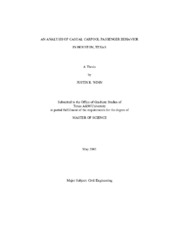| dc.description.abstract | In the last thirty years, determined travelers have developed a new method of travel that
allows them to receive the benefits of traveling on the HOV lane without forming
traditional carpools. This new mode is known as casual carpooling (also known as
??slugging??). Casual carpools are impromptu carpools formed among strangers in order
to meet the occupancy requirements of HOV lanes.
In this research, survey respondent data from Houston, Texas were used to evaluate the
behavior of casual carpool passengers. At the time of this research, there were
approximately 500 casual carpool passengers in Houston each day during the morning
peak period. These passengers gained time savings of up to 13 minutes over the
alternative of driving alone on the main lanes.
Statistical models were used to evaluate the factors that influence travelers to choose
casual carpooling. The results of the analyses indicated that travelers on commute trips
were more likely to casual carpool. The results also indicated that casual carpoolers in
Houston made more trips per week, were between the ages of 25 and 34, and hadoccupations that were either professional/managerial or administrative/clerical.
Additionally, Houston travelers that had incomes between $25,000 and $35,000 and
were between the ages of 55 and 64 were significantly less likely to casual carpool.
The research results provided insight into some of the factors that influenced the
decision to casual carpool. It is important to understand the types of travelers that casual
carpooled, and the information learned in these analyses can be used to better evaluate
HOV and HOT lane use and performance. Casual carpool passengers can comprise a
significant portion of HOV/HOT lane person movement and should be considered when
considering HOV or HOT lane implementation. However, further research in this area is
necessary to better understand these travelers. | en |


